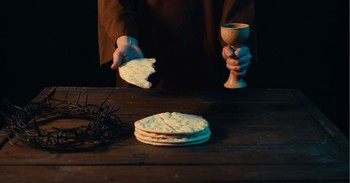From Praying the Names of God Week Nine, Day One

The Name
Ancient armies carried standards or banners that served as marks of identification and as symbols that embodied the ideals of a people. A banner, like a flag, was something that could be seen from afar, serving as a rallying point for troops before a battle. Though banners were first used in Egypt, Babylonia, Assyria, and Persia, the Israelites carried them on their march through the desert. When you pray to Yahweh Nissi, you are praying to the God who is powerful enough to overcome any foe.
Key Scripture
Moses built an altar and called it The LORD is my Banner. He said, "For hands were lifted up to the throne of the LORD. The LORD will be at war against the Amalekites from generation to generation." (Exodus 17:15-16)
***
Monday
GOD REVEALS HIS NAME
The Amalekites came and attacked the Israelites at Rephidim.
Moses said to Joshua, "Choose some of our men and go out to fight the Amalekites. Tomorrow I will stand on top of the hill with the staff of God in my hands."
So Joshua fought the Amalekites as Moses had ordered, and Moses, Aaron and Hur went to the top of the hill. As long as Moses held up his hands, the Israelites were winning, but whenever he lowered his hands, the Amalekites were winning. When Moses' hands grew tired, they took a stone and put it under him and he sat on it.
Aaron and Hur held his hands up—one on one side, one on the other—so that his hands remained steady till sunset. So Joshua overcame the Amalekite army with the sword.
Then the LORD said to Moses, "Write this on a scroll as something to be remembered and make sure that Joshua hears it, because I will completely blot out the memory of Amalek from under heaven."
Moses built an altar and called it The LORD is my Banner. He said, "For hands were lifted up to the throne of the LORD. The LORD will be at war against the Amalekites from generation to generation." (Exodus 17:8-16)
Lord, I thank you for raising your standard over me.Today, as I face spiritual battles of many kinds, help me to be confident of your protection, to fight with your power, to prevail in your strength.Yahweh Nissi, may your victory be total and complete, destroying whatever stands in the way of your plans and purposes.Amen.
Understanding the Name
Unlike fabric flags, ancient banners were usually made out of wood or metal and shaped into various figures or emblems that could be fastened to a bare staff or a long pole. Depicting birds, animals, or gods, they often glistened brightly in the sun so that they could be seen from far off. A banner carried at the head of an army or planted on a high hill served as a rallying point for troops before battle or as an announcement of a victory already won. Because they embodied the ideals and aspirations of whoever carried them, banners aroused devotion to a nation, a cause, or a leader. When Moses held up the staff of God in the battle with the Amalekites, he was holding it like a banner, appealing to God's power. By building an altar and naming it Yahweh Nissi (yah-WEH nis-SEE), "The LORD is my Banner," he created a memorial of God's protection and power during the Israelites' first battle after leaving Egypt.
Studying the Name
- The Amalekites were fierce enemies of the Israelites and the first to attack them after their liberation from Egypt (see Deuteronomy 25:17-19). As members of God's people, we face spiritual enemies intent on destroying God's plans and purposes for our lives. What are some of the enemies you face and how have you dealt with them?
- What does it mean to engage in spiritual battles today? What difference would it make if you could say, like Moses, "The LORD is my Banner"?
For more from Ann Spangler, please visit her blogspot on Christianity.com. And be sure to check out Ann's newest books on AnnSpangler.com. To hear more from Ann Spangler, sign up today at annspangler.substack.com.
Meet your spiritual ancestors as they really were: Less Than Perfect: Broken Men and Women of the Bible and What We Can Learn from Them.




